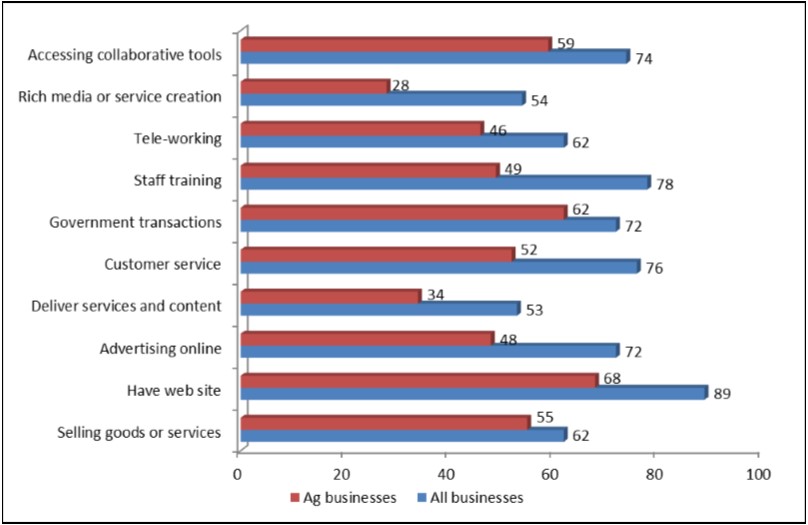Cornhusker Economics July 16, 2014
Technology Use in Agriculture
In September 2013, the Nebraska Broadband Initiative partnered with the Strategic Networks Group (SNG) to conduct an email survey of Nebraska businesses on their use of broadband technologies. Responses from over 800 Nebraska businesses show that broadband is being widely used and is benefiting businesses across the state. The complete report can be found online at http://broadband.nebraska.gov/. Seventy of those businesses self-reported being in the agriculture/forestry/fishing industry. This paper will take a closer look at the responses from this industry sector.
Connectivity, Satisfaction and Use by Agricultural Businesses
One-half of the agricultural businesses connect using either DSL (31.4%) or a fixed wireless connection (18.6%) (Figure 1). An additional 17 percent of agricultural businesses have a fiber connection. Overall, agricultural businesses have higher rates of using dial-up, satellite, fixed wireless and DSL connections when compared to all Nebraska businesses. They are less likely than other businesses to have cable, fiber, and T1 connections. Overall, these latter types of connection technologies have higher levels of satisfaction with both speed and reliability.
Satisfaction with Internet Speed
Given that, it is no surprise that agricultural businesses report lower levels of satisfaction with their Internet speed compared to all Nebraska businesses. Over two in ten agricultural businesses (21%) say their Internet connection is not fast enough, compared to 13 percent of all Nebraska businesses (Figure 2). Conversely, only 12 percent of agricultural businesses say their Internet speed is very fast, compared to 21 percent of all Nebraska businesses.

Overall, most agricultural businesses are utilizing Internet applications. Most are using the Internet to do the following: research by staff (86%), purchasing goods or services (85%), supplier communication and coordination (85%) electronic document transfer (85%), and accessing government information (83%). However, they are less likely than all Nebraska businesses to utilize all of the various Internet applications in their businesses. Some of the areas with the most dramatic differences include: rich media or service creation (e.g., multimedia content, interactive tools) (28% compared to 54%), staff training (49% compared to 78%), customer service (52% compared to 76%), delivery services and content (e.g., video streaming, digitized products) (34% compared to 53%), and advertising online (48% compared to 72%) (Figure 3). These represent areas where utilization of technology can be improved, although some of these areas may not be applicable to all businesses in this industry.

Barriers
The businesses also rated the significance of various barriers to effectively using broadband Internet in their operations. Agricultural businesses rate the following barriers as very important: security concerns (39%), privacy concerns (27%), loss of personal contact with clients (20%) and available Internet too slow (20%) (Figure 4). Over four in ten agricultural businesses also said the following barriers are somewhat important: products not well suited to online sale (41%) and lack of internal expertise and knowledge (43%). Some of these barriers can be overcome with appropriate training.

Use by Agricultural Producers
The respondents were also asked if they operated a farm or agricultural operation. Seventy-five respondents do so. Over one-third (39%) operate a grain farm while just under one-quarter (24%) operate a livestock operation. Thirteen percent have a multi-purpose operation and 25 percent have a different type of operation.
Broadband applications are becoming increasingly important for agricultural producers. Most grain operations are currently using the Internet for the following: commodity prices/market information (77%); crop management (65%); government or regulatory agency reporting (60%); farm business planning (57%); ROI calculators (57%); GPS information (55%); and business accounting (50%) (Figure 5). Most livestock operations are using the following Internet applications: commodity prices/market information (69%); government or regulatory agency reporting (63%); auctions (63%); farm business planning (56%); and direct product sales (50%). In addition, almost three in ten livestock producers are planning to use the Internet for herd management and veterinary services and information in the future.

Videos highlighting examples of how agricultural producers and agribusinesses are using broadband can be found on the Nebraska Broadband Initiative's web site (http://broadband.nebraska.gov). One example is a feedlot in western Nebraska that uses broadband to track many things on site, from feed to the health of each animal. Customers have the ability to view their livestock and monitor their weight and health status through the company's web site.
Agriculture is one of the priority areas for the statewide broadband plan currently under development. A workgroup has been formed that is identifying strategies for enhancing broadband use in this industry. For more information on this workgroup, please contact Anne Byers. Her contact information is listed below.
More information about the Nebraska Broadband Initiative, a summary of the business survey, or the complete report "Nebraska Broadband eSolutions Benchmarking Report: Utilizations and Impacts of Broadband for Nebraska Businesses" may be found at: http://broadband.nebraska.gov/
Broadband Steering Team members include: Gene Hand, Steve Meradith and Cullen Robbins, Nebraska Public Service Commission; Anne Byers, Nebraska Information and Technology Commission; Allison Hatch, State of Nebraska Department of Economic Development; Rod Armstrong, AIM Institute; Roger Terry, UNL Ed Media; Jan Jackson Cejka, Jim Keeler, Charlotte Narjes and Becky Vogt, UNL Department of Agricultural Economics; and Connie Hancock, UNL Extension
Cheyenne County.
The Broadband Mapping and Planning Initiative is funded through a grant to the Nebraska Public Service Commission by the U.S. Department of Commerce's National Telecommunication and Information Administration and aims to increase broadband adoption and utilization. The University of Nebraska is leading the planning efforts. Planning project partners include the University of Nebraska-Lincoln, Nebraska Information Technology Commission, Nebraska Department of Economic Development and AIM Institute.
Becky Vogt, (402) 329-6251
Department of Agricultural Economics
University of Nebraska-Lincoln
rvogt2@unl.edu
Charlotte Narjes, (402) 472-1724
Department of Agricultural Economics
University of Nebraska-Lincoln
cnarjes@unl.edu
Anne Byers, (402) 471-3805
Nebraska Information Technology Commission
anne.byers@nebraska.gov
Connie Hancock, (308) 254-4455
Extension Educator
University of Nebraska-Lincoln
chancock1@unl.edu